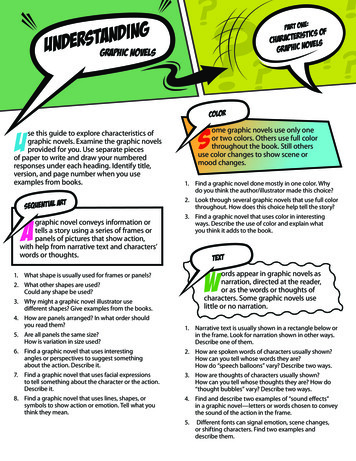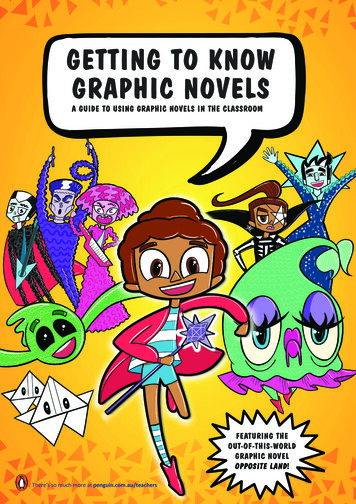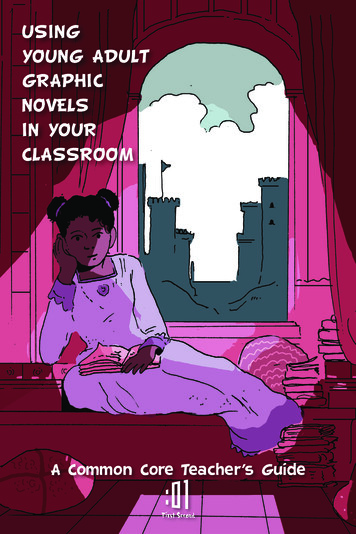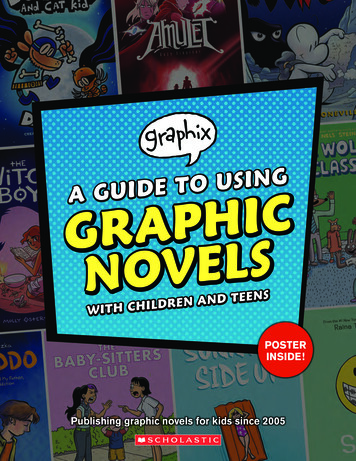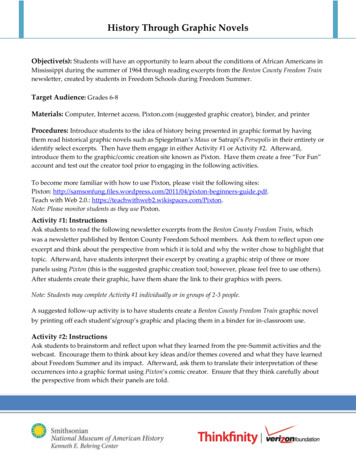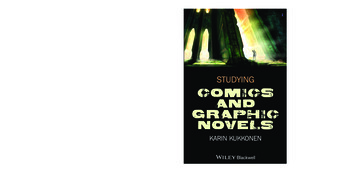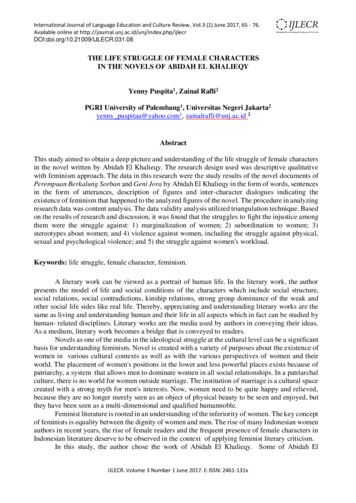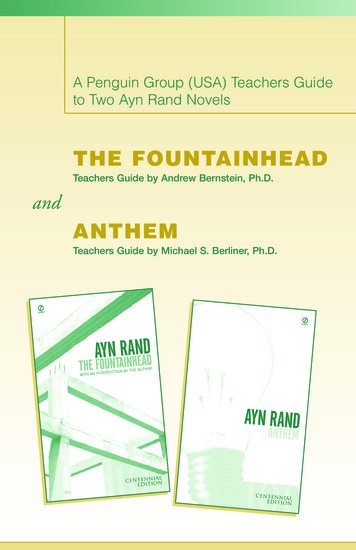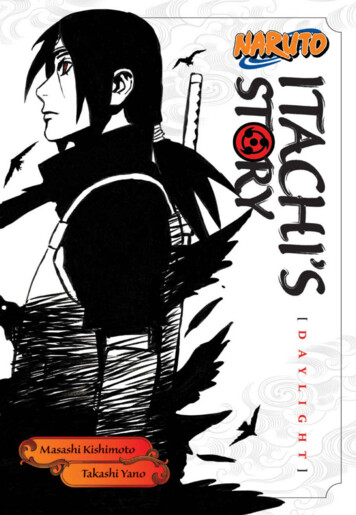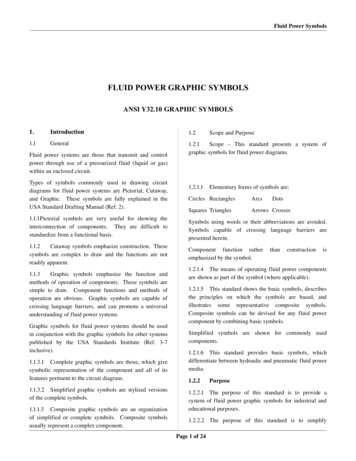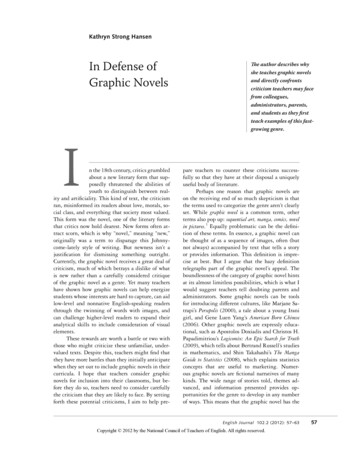
Transcription
Kathryn Strong HansenIn Defense ofGraphic NovelsIn the 18th century, critics grumbledabout a new literary form that supposedly threatened the abilities ofyouth to distinguish between reality and artificiality. This kind of text, the criticismran, misinformed its readers about love, morals, social class, and everything that society most valued.This form was the novel, one of the literary formsthat critics now hold dearest. New forms often attract scorn, which is why “novel,” meaning “new,”originally was a term to disparage this Johnnycome-lately style of writing. But newness isn’t ajustification for dismissing something outright.Currently, the graphic novel receives a great deal ofcriticism, much of which betrays a dislike of whatis new rather than a carefully considered critiqueof the graphic novel as a genre. Yet many teachershave shown how graphic novels can help energizestudents whose interests are hard to capture, can aidlow-level and nonnative English-speaking readersthrough the twinning of words with images, andcan challenge higher-level readers to expand theiranalytical skills to include consideration of visualelements.These rewards are worth a battle or two withthose who might criticize these unfamiliar, undervalued texts. Despite this, teachers might find thatthey have more battles than they initially anticipatewhen they set out to include graphic novels in theircurricula. I hope that teachers consider graphicnovels for inclusion into their classrooms, but before they do so, teachers need to consider carefullythe criticism that they are likely to face. By settingforth these potential criticisms, I aim to help pre-The author describes whyshe teaches graphic novelsand directly confrontscriticism teachers may facefrom colleagues,administrators, parents,and students as they firstteach examples of this fastgrowing genre.pare teachers to counter these criticisms successfully so that they have at their disposal a uniquelyuseful body of literature.Perhaps one reason that graphic novels areon the receiving end of so much skepticism is thatthe terms used to categorize the genre aren’t clearlyset. While graphic novel is a common term, otherterms also pop up: sequential art, manga, comics, novelin pictures.1 Equally problematic can be the definition of these terms. In essence, a graphic novel canbe thought of as a sequence of images, often (butnot always) accompanied by text that tells a storyor provides information. This definition is imprecise at best. But I argue that the hazy definitiontelegraphs part of the graphic novel’s appeal. Theboundlessness of the category of graphic novel hintsat its almost limitless possibilities, which is what Iwould suggest teachers tell doubting parents andadministrators. Some graphic novels can be toolsfor introducing different cultures, like Marjane Satrapi’s Persepolis (2000), a tale about a young Iranigirl, and Gene Luen Yang’s American Born Chinese(2006). Other graphic novels are expressly educational, such as Apostolos Doxiadis and Christos H.Papadimitriou’s Logicomix: An Epic Search for Truth(2009), which tells about Bertrand Russell’s studiesin mathematics, and Shin Takahashi’s The MangaGuide to Statistics (2008), which explains statisticsconcepts that are useful to marketing. Numerous graphic novels are fictional narratives of manykinds. The wide range of stories told, themes advanced, and information presented provides opportunities for the genre to develop in any numberof ways. This means that the graphic novel has theEnglish Journal 102.2 (2012): 57–6357Copyright 2012 by the National Council of Teachers of English. All rights reserved.EJ Nov2012 B.indd 5711/7/12 1:24 PM
In Defense of Graphic Novelspotential to appeal to almost any reader. So despitethe definitional and terminological issues, graphicnovels are a vibrant and compelling tool for teaching, and in particular the teaching of writing andof literature.Criticism from Outside the ClassroomBefore discussing how to prepare for some unexpected battles, I will first address the criticismslikely to emerge from disapproving voices outsidethe classroom that teachers might indeed expect.One such expected argument raised against graphicnovels, likely related to their most common name,is that they’re too violent, too brutal, or, in a word,too graphic. This criticism might refer to the superhero comics, in which overlyUneasy teachersmuscled characters show theircan find a valuableworth by physically subduingtheir antagonists. In some reresource in theirspects, this is a valid criticism,local comics shop;especially when the assumedmanagers and workersaudience consists of youngthere can help teacherschildren, even though it is asearch throughradically simplistic overviewgraphic novels to findof superhero graphic novels.As is the case with any genrethose that are bestof text, not all graphic novelssuited to particularare intended for younger auclassroom needs.diences. This is a notion thatteachers must keep in mind. To help emphasize thispoint, think of it this way: many currently popularanimated television shows are analogous to graphicnovels. That is, some people think that the seemingly childish format (animation for televisionshows or “cartoon art” for graphic novels) indicatesthat the material is targeted at children. As showssuch as Family Guy and South Park demonstrate,this is not always the case. But the need for teachers to choose graphic novels wisely shouldn’t bar allgraphic novels from classroom use. Some graphicnovels have names that pretty clearly label them asbeyond the pale for most school use, such as Jhonen Vasquez’s Johnny the Homicidal Maniac (1995–97). Others, including Frank Miller’s Hard Boiled(1990–92); John Wagner, Carlos Ezquerra, and PatMills’s Judge Dredd (1990–present); and John Albano’s Jonah Hex (1971–present), are just as inappro-58priate for young children, though an examinationof them is necessary to ascertain that. If a noviceteacher of graphic novels is worried about text selection, aids exist that provide guidance for usinggraphic novels in the classroom (see fig. 1). Uneasyteachers can also find a valuable resource in theirlocal comics shop; managers and workers there canhelp teachers search through graphic novels to findthose that are best suited to particular classroomneeds.But the existence of objectionable material insome examples of the form does not excuse opposingthe entire canon of graphic novels. Graphic novelsrange widely in content, so careful selection of textsby instructors can obviate these kinds of claims.First and foremost, no teacher should use a graphicnovel that she or he has not read. These texts vary inquality as well as content. This shouldn’t be a surprise, but like most genres, the genre of the graphicnovel encompasses a wide range of topics. Thoughmany critics of the form believe that punches andbullet sprays are the hallmarks of all graphic novels, this is absolutely untrue. For instance, CraigThompson’s Blankets (2003) tells a story of a teenfrom an evangelical Christian background and hisdifficulties in coming of age. Its panels are showcases of the tumultuous nature of first love and ayoung man’s maturation, not fisticuffs—emotionalintensity, not physical violence. For middle school–aged readers, Barry Deutsch’s Hereville: How MirkaGot Her Sword (2010) provides a plucky youngheroine who comes to terms with her longing for aless-traditional life even as she learns better to understand her stepmother. These complex charactersexemplify the wide range of graphic novel characters who exist in a world far apart from one featuring battles between superheroes and supervillians.Even those who don’t find themselves bothered by violence might complain that graphicnovels are easy texts for lazy readers. This is by nomeans the case, but this might be the most persistent criticism to combat. Yet challenging andengaging graphic novels abound. Neil Gaiman’sThe Sandman series (1989–96) frequently makesallusions to classical literature, for example, withthe character of Orpheus from Greek myth making repeated appearances. Gaiman also riffs on theplots of William Shakespeare’s A Midsummer Night’sNovember 2012EJ Nov2012 B.indd 5811/7/12 1:24 PM
Kathryn Strong HansenFIGURE 1. Resources for Beginning to UseGraphic Novels in the ClassroomCarter, James Bucky, Ed. Rationales for TeachingGraphic Novels. Gainesville: Maupin House, 2010. CDROM. This sets forth synopses and potential objectionsfor almost 100 graphic novels, giving educators information to explain these works’ worth to administrators.Comic Shop Locator, http://www.comicshoplocator.com/. This site allows users to find comic shops in theirvicinity and provides additional information, such asgraphic novel reviews and notifications of upcomingconferences.Comics Worth Reading, http://comicsworthreading.com. This site offers Johanna Draper Carlson’s catalogof graphic novels, manga, and other related works. Her“Must-Read Comic Classics” list is a good startingpoint.Cooperative Children’s Book Center, vels.asp. TheUniversity of Wisconsin–Madison’s School of Educationhosts this site, which provides lists of recommendedgraphic novels as well as resources for understandingand defending them.Graphic Novels Program Guide, files/NA63 web.pdf.Bright Point Literacy’s guide includes ideas for usinggraphic novels in the classroom.Great Graphic Novels for Teens, http://www.ala.org/yalsa/ggnt. This site showcases the Young Adult LibraryServices Association’s list of recommended graphic novels for older children.Newsarama, http://www.newsarama.com/. Actor/director Kevin Smith’s site keeps abreast of graphicnovel news, including reviews and information aboutmovie adaptations.No Flying, No Tights, http://noflyingnotights.com/.This website is a storehouse for reviews of graphic novels that do not feature superheroes.Teaching Comics, http://www.teachingcomics.org. Thewebsite of the National Association of Comics Art Educators provides lesson plans, handouts, study guides,and other resources for classroom use of graphicnovels.Using Graphic Novels with Children and Teens: A Guidefor Teachers and Librarians, -and-librarians. Scholastic’swebsite provides a printable PDF that offers graphicnovel suggestions for young readers, middle gradereaders, and young adult readers as well as a list ofadditional resources for educators.Young Adult Library Services Association, wards/greatgraphicnovelsforteens/gn.cfm. This site gives an annuallist of “Great Graphic Novels for Teens.”Dream and Geoffrey Chaucer’s The Canterbury Talesin installments of The Sandman, creating possiblejumping-off points for introducing—or reexamining—those works. Even without taking intoaccount the beautiful and compelling images inGaiman’s graphic novels, their complex stories andrich character developmentWhile most peoplecreate pleasurable chalclaim to honor art as alenges for readers. Gaiman’swork serves as only one excultivating force, some ofample; another engagingthose same people alsopiece of literature is foundloudly oppose graphicin David B.’s autobiographnovels because they soical graphic novel Epilepticheavily rely on visual(2002). The central characelements.ter’s family slowly unravelsas they try to cure his epileptic brother. A moving account of how familiesexperience suffering and disease, it also shows theyoung protagonist’s escape into imagination as acoping mechanism. As a result, this graphic novelraises issues of the differences between literality andmetaphor. These examples demonstrate only a tinybit of the complexity offered in the plot, characterization, and themes of graphic novels.But it’s also important to take into accountthe subtlety and beauty of graphic novels’ artwork.The argument of lazy readership discounts thepower and impact of images. While most peopleclaim to honor art as a cultivating force, some ofthose same people also loudly oppose graphic novels because they so heavily rely on visual elements.Imagery and drawings are not inherently less valuable than verbal, “literary” art. In fact, images oftenconvey a richness and depth of ideas that requireinterpretation and high-level critical thinking,analysis, and evaluation skills. These are the samekinds of thinking skills and interpretative activitiesthat reading affords students, and I invite teachers to remind skeptics of this. Take as an examplea panel from Art Spiegelman’s Pulitzer Prize–winning graphic novel Maus I (1986), an account ofone family’s struggles to survive the Holocaust. Inone sample panel (125), two mouse-headed characters walk on a path through what looks like a park.The simplicity of the drawing style initially mightappear sweet and charming—and it is. But thispanel simultaneously shows the relentlessness andEnglish JournalEJ Nov2012 B.indd 595911/7/12 1:24 PM
In Defense of Graphic Novelsinescapability of Nazism, because even the paththat these characters tread is shaped like a swastika.The darkness and twisted lines of the landscape underscore and enhance this feeling of pervasive doom.When juxtaposed with the sweetness of line drawings of mice, the enormity of the horror imposedby the Holocaust is thrown into starker contrast.This one panel provides an opportunity for studentsto explore an image that provides no words forthem, though the panel is by no means unusual inits depth for a graphic novel panel. To describe thisscene, students have to take the role of producers oflanguage. In this way, graphic novels can serve as abasis for writing and critical thinking assignments.They serve as a way of presenting information in aninteresting and engaging manner to spark students’attention, and such assignments demand that students actively produc
ning graphic novel . Maus I (1986), an account of one family’s struggles to survive the Holocaust. In one sample panel (125), two mouse-headed charac- ters walk on a path through what looks like a park. The simplicity of the drawing style initially might appear sweet and charming—and it is. But this panel simultaneously shows the relentlessness and . While most people claim to honor art as .
